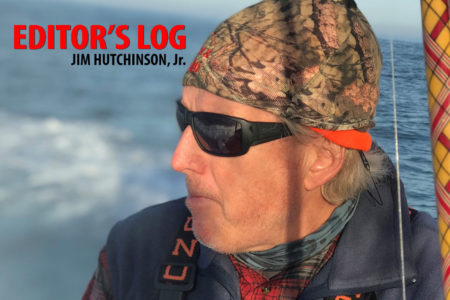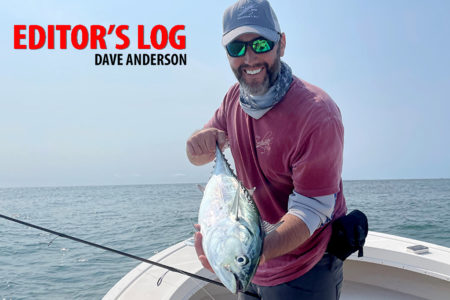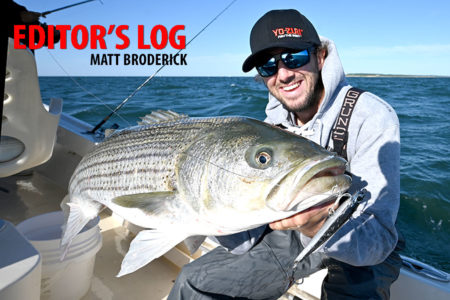Call it the Striped Bass Do Si Do, or maybe a little Hokey Pokey; I’m not 100 percent up on what dance moves the kids are doing these days since I stopped doing the “Running Man” and the “Cabbage Patch” a long time ago, but this feels like little more than a square dance gone wrong to me.
On April 25, the Massachusetts Division of Marine Fisheries (DMF) released the following notice:
NEW STRIPED BASS CONSERVATION REGULATIONS
The Massachusetts Division of Marine Fisheries has implemented two new striped bass conservation regulations aimed at reducing release mortality:
- Effective immediately, it is unlawful for any fisherman to gaff or attempt to gaff striped bass measuring less than 28 inches total length, and for a commercial fisherman fishing on an open commercial striped bass fishing day to gaff striped bass measuring less than 34 inches total length.
- Effective next year (2020), recreational anglers not fishing aboard for-hire vessels will be required to use inline circle hooks when fishing for striped bass with whole or cut natural baits. This will include fishing with whole or cut natural baits while in possession of striped bass as well. This circle hook mandate will not apply to natural baits attached to an artificial lure to be trolled, jigged, or casted and retrieved (e.g., tube and worm). Nor will the mandate apply to any natural bait affixed to a treble hook and fished using the snag and drop technique. A hook is considered to be an in-line circle hook only if it is manufactured so the barb of the hook is in-line with the shank and bend of the hook and is turned perpendicularly back to the shank to form a circular or oval shape.
The most recent striped bass stock assessment found the species was overfished with overfishing occurring. In addition, it demonstrated that release mortality from the recreational fishery is the single largest source of fishing mortality (48 percent). Accordingly, these actions have been taken to reduce release mortality in our fisheries. The prohibition on gaffing undersized striped bass (as opposed to all striped bass) takes into consideration safety concerns associated with expediently removing large striped bass from the water. In-line circle hooks are proven to substantially reduce striped bass release mortality compared to other hooks (e.g., j-hooks or offset circle hooks) by being far more likely to hook the fish in the lip or the mouth and not the gut or the gills. The circle hook mandate is targeted at private recreational anglers because this segment of the fishery is primarily hook-and-release and accounts for the vast majority of recreational striped bass catch in Massachusetts. We expect the Atlantic States Marine Fisheries Commission will also take action this year to implement coastwide conservation measures for 2020 aimed at reducing overall fishing mortality.
For more information regarding the management of striped bass in Massachusetts, please visit our website (www.mass.gov/marinefisheries) or call DMF at 617-626-1520.
Initially I was happy to see this conservation-minded effort by the DMF, but upon further review, after being watered down from its initial measures, all it appears to do is further solidify the divide between recreational and commercial anglers as well as the divide within the recreational ranks of private and for-hires at a time when we should all be coming together to do what’s best for the striped bass. So let’s review the decision.
It’s now illegal to gaff undersized striped bass. The absurdity that this even needs to be written into law is beyond comprehension. There is no reasonable excuse why anyone needs to use a gaff on a striped bass. It’s already illegal to gaff a striped bass of any size in Connecticut, for example, and that hasn’t put the striped bass fishery on hold. Heck, the World Record striped bass was caught in Connecticut without the use of a gaff so anyone saying they can’t land a bass of any size without gaffing it should rethink how they go about landing a fish!
End Result: One step forward on making it illegal to gaff a striped bass +1 step back backwards because you can still gaff a fish of legal harvest length (regardless of your intent on said fish) = NO GAIN/NO LOSS.
Private anglers must now use inline circle hooks when using whole or cut natural bait. This is great news except for the caveat that it does not apply to anglers fishing onboard for-hire boats, it does not apply to commercial fishermen and it does not “apply to any natural bait affixed to a treble hook and fished using the snag and drop technique.” All this regulation really serves to do is promote snag and drop fishing where the angler does not transfer the hooked bait to a single hook AND attack the average private recreational angler. It sets both commercial and for-hires into a different category of gear use and stokes negative sentiment.
End Result: One step forward for mandate of inline circle hooks + 1 step backwards for allowing the snag and drop caveat + 1 step backwards for excluding commercial anglers from the requirement + 1 step backwards for excluding for-hire anglers from the requirement 2 steps backwards for further dividing fishermen = LOSS OF 4 STEPS.
The DMF had an opportunity to make some real change and perhaps take steps towards righting the wrong of striped bass management which has been going on for some time now, but instead all they did was spin around a few times and fall flat on their face. Release mortality is the hot-button topic of striped bass water cooler chatter since the winter meeting of the Atlantic States Marine Fisheries Commission (ASMFC) when it was announced that some 50% of all striped bass harvest is due to dead discards (48% for recreational and 2% for commercial anglers) in 2017. Preliminary talk of new regulations coming down the pipeline in 2020 from the ASMFC include steps to work towards correcting this wasteful harvest, and while some of what the DMF has done will address this concern, it falls painfully short of resulting in any grand improvement. As the proposal was originally written the measures applied to all anglers on the circle hook issue and all fish, regardless of size, on the gaff issue, and that is how it should have been approved if the end goal was to truly make a positive change.
I guess in all reality I shouldn’t be surprised that things ended up the way they have. Leading up to this decision it was the for-hires and commercial anglers who took meaningful opposition to the changes through the public hearings while private recreational anglers took to their usual social media soap box to point fingers, argue amongst themselves and act like children bickering over who ate the last cookie in the jar.



